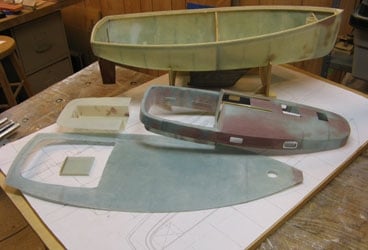
model catboat 368
The benefit of sitting backward while rowing? As we pull toward shore, our eyes can play over our boat resting at anchor, leaving us to admire her graceful lines and contemplate our next sail. These are universal feelings, whether the boat is an O’Day 22 or a glorious Hinckley Sou’wester.
Such feelings inspired me to build a model of my Nonsuch 260, which would allow me to admire her on the mantle as well as at anchor. My modeling experience was limited to boyhood model airplanes and a little whittling. But I found the project to be not impossible; patience and perseverance were the keys to success.
Should you decide to make a model of your own boat, perhaps my experience will inspire and instruct.
To begin, I purchased plans for my Nonsuch 260 from the designer. I had planned to use a 1:12 scale, and fortunately, the plans were drawn to this scale. I decided to make the hull from fiberglass laid over a foam mold. I copied the station lines, one for each station, on to card stock, which I then carefully cut out with scissors. These were then glued to blocks of urethane foam the exact thickness of the distance between stations, the bottom edge of each station exactly in line with the bottom of each block of foam. I glued the blocks of foam together in sequence on a flat piece of plywood, but not to the plywood, then shaped the foam by sanding until the sandpaper just touched the card-stock stations and the surface between stations was fair. Over the foam, I applied six layers of 6-ounce fiberglass cloth using epoxy resin, which, when cured, I sanded smooth. Imperfections were filled with epoxy putty, then sanded again. WEST System literature provided complete guidance about the epoxy and fiberglass I used.
The deck, cabin, and cockpit were built in separate pieces using the same process as the hull. Again, I sanded and faired and sanded again. The cabin and cockpit were then glued to the deck. Then I glued the deck to the hull after some minor trimming to fit. The keel was built of wood, except for the bulb, which I made from lead.
I first shaped the bulb from wood, then used it to make a plaster-of-paris mold into which I poured molten lead obtained by melting scrap tire weights. Working with lead can be dangerous, so use extreme caution doing this.
I glued up strips of Sitka spruce to make the mast, which is hollow to accommodate internal halyards. Shaping was done with sandpaper glued to a fairly long, 1-inch by 2-inch sanding board. The boom was built similarly. Although I made my blocks out of hardened bits of epoxy using a lathe and files, miniature blocks, rigging wire, turnbuckles, cleats, and the like can be found at Loyalhanna Dockyard (www.loyalhannadockyard.com) and other Internet sites.
Stanchions, bow and stern pulpits, a pedestal guard, and a wheel were made from brass rod, tubing, and solder. The bow and stern pulpits were a little difficult-there’s no precise way to get the bends right except by eyeballing. This took a couple of tries.
I fabricated the ports from fiberglass, painted with spray paint, and added sails I bought from Rod Carr (CarrSails.com).
This brief overview of my model building isn’t intended to guide you through every step in detail; that would fill a book. Rather, it’s intended to encourage you to have a go at building your own mantle yacht. All you need to do is combine imagination with patience and perseverance.
When he’s not making a model of his Nonsuch 260 Polecat, Paul Ring is sailing the full-sized one near Fairhope, Alabama. Readers attempting to build their own models may contact the author (pering@bellsouth.net) for guidance.








